Text


2,500-Year-Old Greek-Illyrian Helmet Discovered in Croatia
Archaeologists discovered a Greek-Illyrian helmet dating 2,500 years in very good condition on Croatia’s Pelješac peninsula.
The same team that found the Greek-Ilyrian helmet in 2020, in the same place, has found the next helmet, which according to the first analysis is older than the one found earlier.
The previous example most likely belonged to a member of the warrior elite who was interred there because it was discovered in a grave with pieces of iron weapons.
Archaeologists think the recently discovered helmet may have been a votive deposit because it was discovered in a dry stone-walled addition to a grave.
Greco-Illyrian type helmets originated in Peloponnese, Ancient Greece, where it likely evolved from the Kegelhelm (or Kegel type) of the Archaic Period.
The Greek-Illyrian helmet is extremely rare
Both of the helmets found are of different types and dates: The helmet discovered in 2020 was of a type commonly used in Greece and Illyria in the 4th century BC. It was an open-faced helmet with a rectangular cross-section for the face and decorative edges.
The newly found helmet is thought to date from the 6th century BC and is extremely rare. Finding two different Greek-Illyrian helmets at one site is unprecedented.
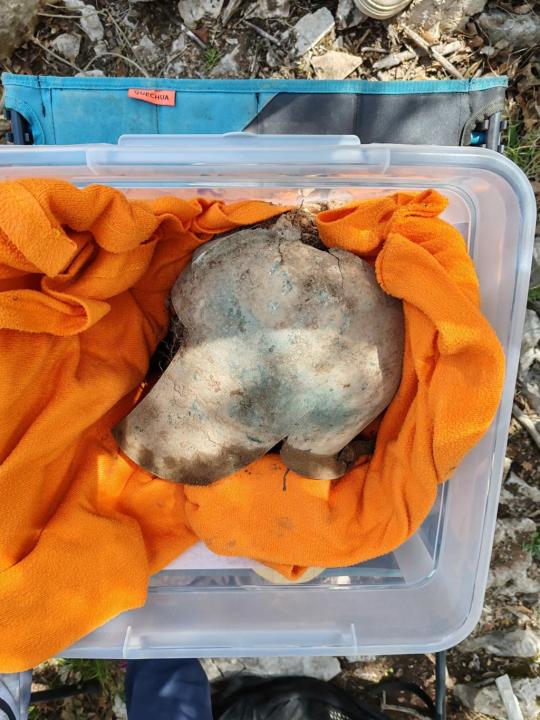

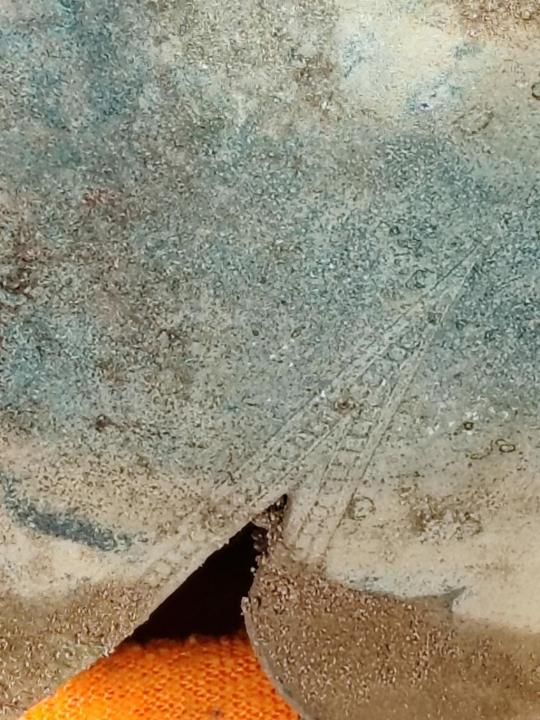
This find, along with a wealth of clothing, jewelry, and burial artifacts unearthed since the excavations began, greatly expands our knowledge of the funeral practices of Illyrian communities in the latter half of the first millennium BC.
The Illyrians were a group of Indo-European-speaking people who inhabited the western Balkan Peninsula in ancient times. They constituted one of the three main Paleo-Balkan populations, along with the Thracians and Greeks.
“What is very interesting is that two different types appear here in the same place, which speaks of a continuity of power of the respective community. These helmets have always been a symbol of some kind of status and power,” said Professor Hrvoje Potrebica, from the Department of Archeology of the Faculty of Philosophy in Zagreb.
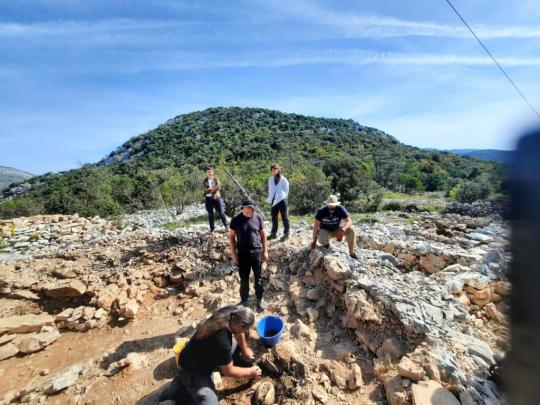
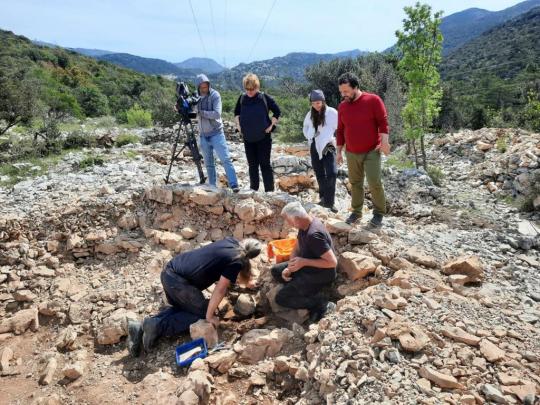
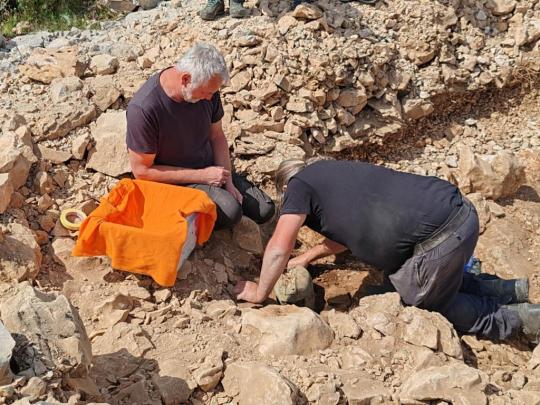
Speaking on the discovery, a representative from the Dubrovnik Museum said: “Along with numerous finds of jewelry, costumes and grave goods, this find of a helmet contributes in many ways to the knowledge of funeral rituals of Illyrian communities in the second half of the last millennium BC, and it ranks the area of Pelješac as one of the most important archaeological zones of the eastern Adriatic coast.”
Recently, archaeologists in Southern Italy have unearthed several significant artifacts, including two helmets, fragments of weapons and armor, and pottery shards, at an archaeological site in the ancient Greek city of Velia.
By Tasos Kokkinidis.
#2500-Year-Old Greek-Illyrian Helmet Discovered in Croatia#ancient Greek city of Velia#ancient artifacts#archeology#archeolgst#history#history news#ancient history#ancient culture#ancient civilizations#greek history#greek art
39 notes
·
View notes
Text

Gigantic Marine Reptile Fossil Found by 11-Year-Old Girl and Father
A massive jawbone found by a father-daughter fossil-collecting duo on a beach in Somerset along the English coast belonged to a newfound species that’s likely the largest known marine reptile to swim in Earth’s oceans.
Scientists consider the blue whale, which grows up to 110 feet (33.5 meters) long, to be the largest known animal ever to exist on the planet. But it’s possible that the 202 million-year-old reptile, known as an ichthyosaur or “fish lizard,” may have rivaled it in size.


The ichthyosaur’s jawbone, or surangular, was a long, curved bone at the top of the lower jaw just behind the teeth, and it measured more than 6.5 feet (2 meters) long. Researchers believe the creature, named Ichthyotitan severnensis, or “giant fish lizard of the Severn” in Latin, was more than 82 feet (25 meters) long, or the length of two city buses.
Justin and Ruby Reynolds, who live in Braunton, England, recovered the first pieces of the jawbone in May 2020 as they looked for fossils on the beach at Blue Anchor, Somerset. Ruby, 11 at the time, spotted the first chunk of bone, and then she and her dad found additional pieces together.
By Ashley Strickland.
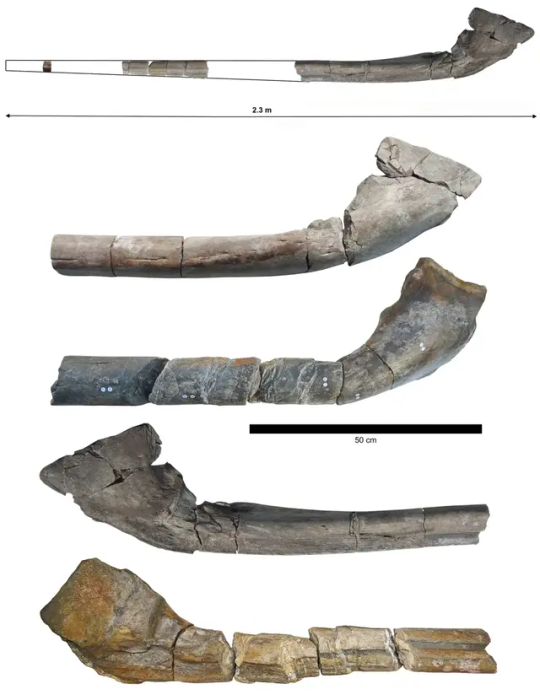
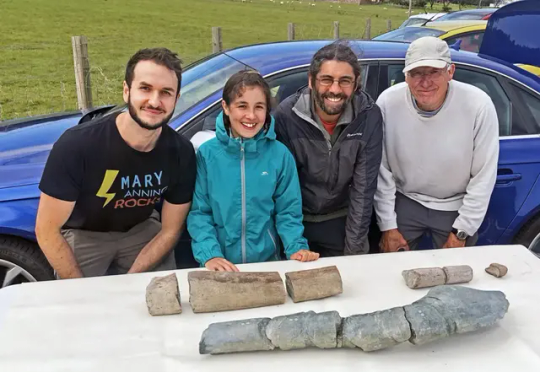
#Gigantic Marine Reptile Fossil Found by 11-Year-Old Girl and Father#Somerset#ichthyosaur#Ichthyotitan severnensis#giant fish lizard of the Severn#fish lizard#ancient artifacts#archeology#archeolgst#history#history news#ancient history#fossils
16 notes
·
View notes
Text
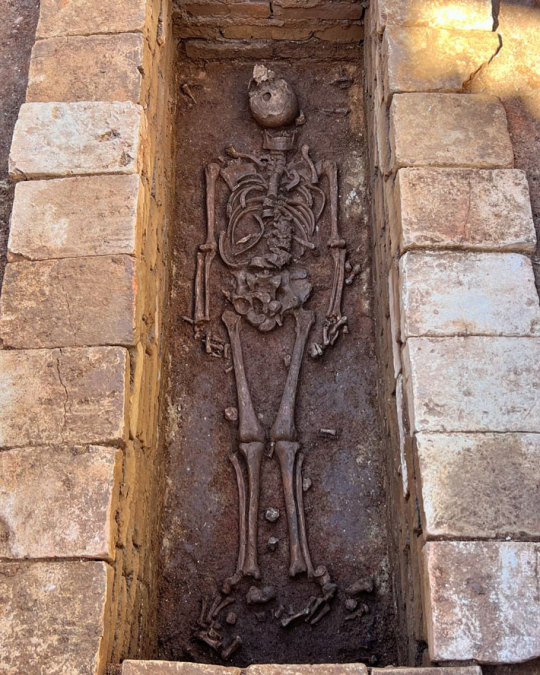
Three Roman Graves Uncovered in Portugal
Three burials dating to the 5th or 6th century AD have been unearthed in the ancient Roman city of Ossónoba in Faro, southern Portugal.
The Ossónoba’s first archaeological evidence dates back to the 4th century B.C., when the Phoenicians settled in the Western Mediterranean. The city was then called Ossónoba From the 2nd century B.C. until the 8th A.D. the city was under Roman and Visigoth dominance being afterwards conquered by the Muslims in 713.
A team of archaeologists from ERA Arqueologia discovered ancient Roman structures and the remains of a man, woman, and child while conducting excavations over a 5,000 square meter area that will eventually house a real estate development.
The excavations, which took place before a construction project, revealed the grave of a man whose skeleton was complete and who would have been between 39 and 45 years old, as well as a young woman under the age of 25, and a baby who would have been no more than six months old, according to archaeologist Francisco Correa.
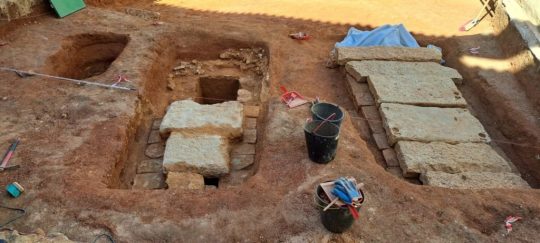
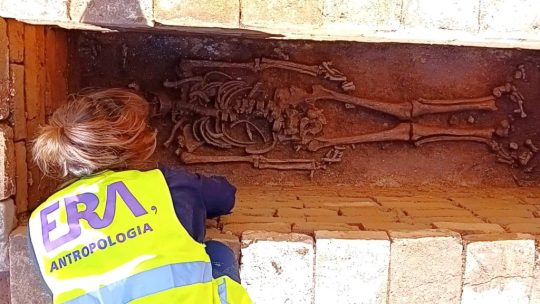

Francisco Correia, the project’s head archaeologist, said in a statement that the discoveries were made in an old truck repair workshop and are believed to date from the 5th or 6th century.
The tombs appear to have been looted in the past to steal “small bracelets, necklaces, and rings,” according to anthropologist Cláudia Maio. The tombs indicate that the people may have had “some economic status” as they were not simply placed in open graves but instead buried in carefully built graves.
The proximity of the three people’s graves seems to indicate that they were family members, though the team cannot be certain of that. “But we cannot say anything for sure,” the anthropologist said.
To learn more, the researchers hope to be able to provide more precise answers through DNA tests and isotopic analysis techniques used to determine population movements and dietary habits from chemical traces in ancient human remains.
This latest archaeological discovery did not come as a surprise to archaeologists, who had already led similar works which resulted in the discovery of a Roman game artifact believed to date back to the first century AD in 2020.

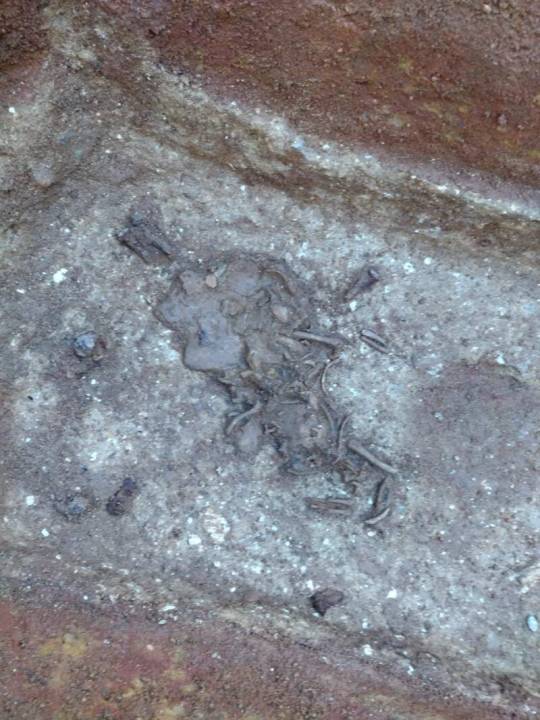

“We know that we are in an area with archaeological potential where there is a 17th-century convent (of Santo António dos Capuchos) to the west, and to the east lies the area where the mosaic of the Ocean God (Deus Oceano), now a national treasure, was found,” he said.
What did come as a surprise to archaeologists was the location of the tombs.
“Based on previous studies, this would have been an area that was possibly residential or more linked to industrial activities. There are many traces of salterns. Largo da Madalena would have been the entrance to the urban area of the city of Ossónoba. The identified graves are in the Figuras area, near Teatro Lethes, close to the Ermida de São Sebastião and the Pavilion of Escola D. Afonso III. This area is almost within the urban fabric,” the archaeologist explained, adding that this illustrates both the “growth and decline of Ossónoba.”
The graves of the man and the woman “were sealed with limestone slabs,” believed to be reused parts from “some of the most emblematic buildings that would have been here in the area,” he believes.
According to the project manager of ERA Arqueologia, who was co-responsible for the work, in addition to the graves, hundreds of small pieces were also discovered which suggest that there may also have been a mosaic there.
The researchers also recovered Roman artifacts in the area, including ceramics, bone dice, nails, pins, a spoon, possible evidence of a dye factory, and coins minted during the reign of Constantine the Great, between A.D. 306 and 337.
Cover Photo: Roman mosaic of the god Oceanus, part of the ancient city of Ossónoba, the modern town of Faro, in Portugal.
By Leman Altuntaş.
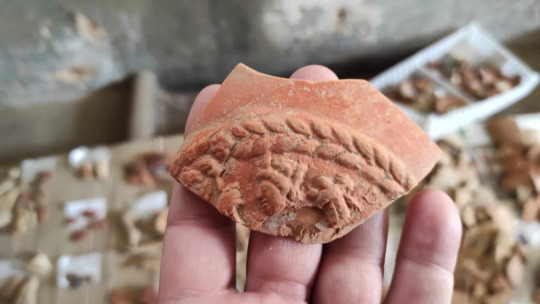

#Three Roman Graves Uncovered in Portugal#Roman city of Ossónoba in Faro#ancient grave#ancient tomb#ancient artifacts#archeology#archeolgst#history#history news#ancient history#ancient culture#ancient civilizations#roman history#roman empire#roman art
76 notes
·
View notes
Text
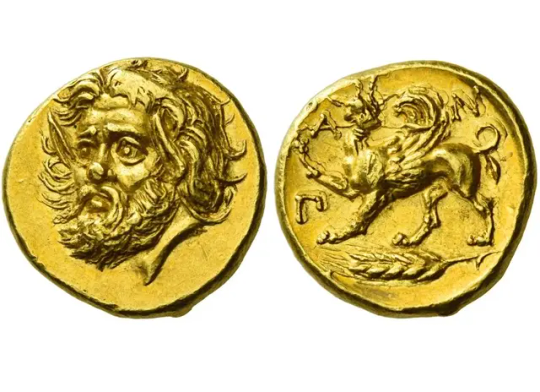
A 2,000-Year-Old Gold Greek Coin Sells for $6 Million at Auction
The coin once belonged to the State Hermitage Museum until it was sold off by Joseph Stalin.
A private collector has spent a pretty penny to get their hands on a 2,000-year-old gold Greek coin.
Known as a Panticapaeum stater, after the ancient Greek city in modern-day Crimea, the coin went for $6 million at Numismatica Ars Classica in Switzerland making it the most expensive ancient coin ever sold at auction.
The soaring price has been attributed to the coin’s quality, rarity, and the fact the supply of similar specimens is extremely limited with most already housed inside museums.
“I am extremely pleased with the phenomenal result the sale of the Panticapaeum stater achieved at our latest auction in Zurich,” Arturo Russo, co-director at Numismatica Ars Classica, said in a statement. “This is a sign the whole market for numismatics is flourishing, and is especially strong for ancients at the moment.”
The coin was minted circa 340–25 B.C.E. and features a wide-eyed satyr on the obverse and that of a griffin gripping a spear in its beak on the reverse. The presence of the satyr, a mischief-maker in Greek mythology that resembles a man with horse ears and a tail, is thought to reference king Satyros I, who ruled a Greco-Scythian empire in eastern Crimea from 432 to 389 B.C.E.
The sharp details make numismatists confident the coin is the work of a master engraver. Unlike similar coins, this Panticapaeum stater features the satyr facing three-quarters to the left, as opposed to facing fully left, a detail experts believe was altered in an attempt to follow contemporary fashions.
The coin was long part of the State Hermitage Museum’s collection, but was sold off in 1934 as part of Stalin’s push to sell works of art to raise foreign currency to fund domestic industrial growth. The coin was acquired by Charles Gillet, a French industrialist who focused on collecting rare books, furniture, and antiquities, including coins.
The previous record for most expensive ancient coin sold at auction was one of only three known “Ides of March” coins, which was minted in 42 B.C.E. and commemorated the assassination of Julius Caesar. It sold at Roma Numismatics auction house for $4.2 million in 2020, though, as it turned out, with falsified provenance.
By Richard Whiddington.

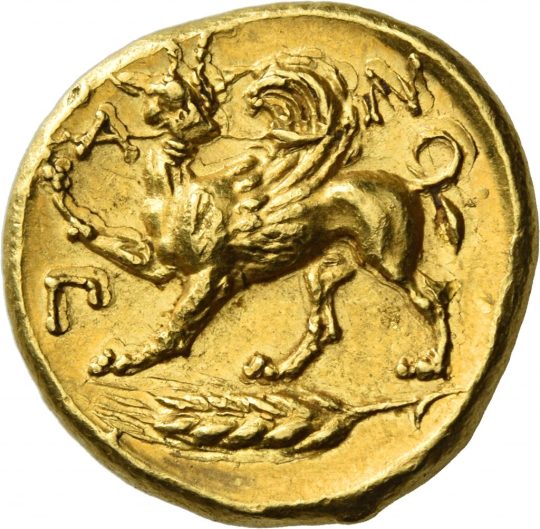
#A 2000-Year-Old Gold Greek Coin Sells for $6 Million at Auction#Panticapaeum stater#king Satyros I#gold#gold coin#ancient coins#ancient artifacts#archeology#archeolgst#history#history news#ancient history#ancient culture#ancient civilizations#ancient greece#greek history#greek art
37 notes
·
View notes
Text

Ancient Noble Tomb Found in China
A noble tomb has been found in a cemetery dating back to the Six Dynasties period (222-589) in the city of Zhenjiang, east China's Jiangsu Province, according to the city's cultural relics and archaeology institute.
The owner of the tomb, named Zhao Xuanzhi, was the uncle of an emperor during the Southern Dynasty (420-589).
Archaeologists found a bronze seal in Tomb No. 6 that helps identify the owner of the tomb. "The bronze seal found in Tomb No. 6 has been confirmed as Zhao Xuanzhi's personal seal. The age of the tomb is consistent with historical records," said Li Xidong, deputy director of the city's cultural relics and archaeology institute.
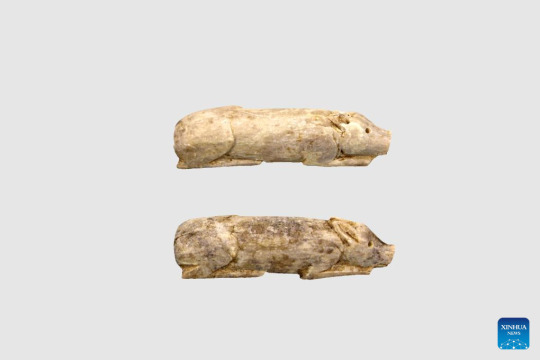

Twenty funerary objects were also unearthed from Tomb No. 6, mostly distributed near the altar at the front of the tomb chamber.
Archaeologists found 13 tombs during recent excavations, seven of which were brick chamber tombs of aristocrats from the Eastern Jin Dynasty (317-420) to the Southern Dynasty, while six others were pit tombs of civilians from the Ming and Qing Dynasties (1368-1911).
Archaeologists said most of the tombs found in the cemetery of the Six Dynasties period belong to the Eastern Jin Dynasty, which provides evidence of people at that time moving from the north to the south. The discovery provides important clues and material data for the study of ethnic migration in Chinese history.
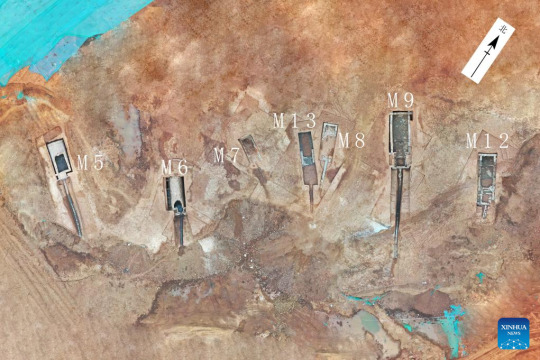
#Ancient Noble Tomb Found in China#Zhenjiang#Jiangsu Province#Six Dynasties period#Zhao Xuanzhi#ancient tomb#ancient grave#ancient artifacts#archeology#archeolgst#history#history news#ancient history#ancient culture#ancient civilizations#ancient china#chinese history#chinese art
24 notes
·
View notes
Text


Rare Silver Coins Dating Back To The 1100s Found in Sweden
From a distance, the slate gray roof and central white tower of the Brahekyrkan church appear charming. The idyllic building is situated on a small island in southern Sweden and surrounded by a cemetery dotted with flowers.
So archaeologists weren’t surprised when a construction project at the church uncovered several skeletons — but the grave held an 800-year-old mystery, too.
Archaeologists began excavations at the Brahekyrkan church in Visingsö to prepare for the installation of a geothermal heating system, the Jönköping County Museum said in a March 27 news release.
On the first day of the excavation, the team found two skeletons, Anna Ödéen, an archaeologist with the museum, said in the release. One belonged to a man between 20 and 25 years old, but the other was not identified.
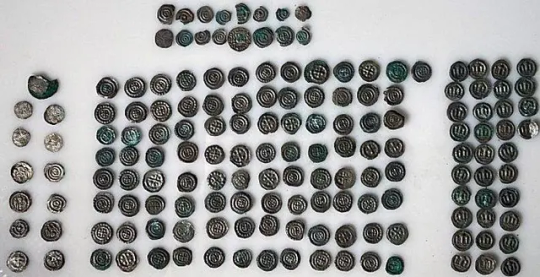
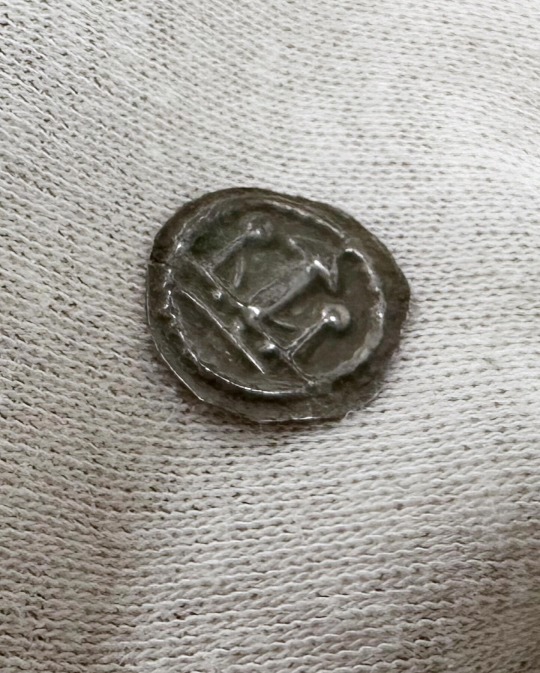
As they cleaned the grave, three silver coins emerged, Ödéen said. Then, more coins surfaced near the skeleton’s left foot.
In total, archaeologists found 170 silver coins dating between 1150 to 1180, the museum said.
Some of the 800-year-old artifacts had completely unknown designs, the museum said. Archaeologists described it as sensational and unique.
The find was also rare because Christian graves during the 12th century typically did not include any artifacts, the museum said. The tradition of burying people with objects was common during older, prehistoric eras.


Archaeologists don’t know why the deceased was buried with the rare coins. Excavations at the church and analyses of the coins are ongoing in hopes of solving this mystery.
Visingsö is an island in southern Sweden and about an 180-mile drive southwest from Stockholm.
By Aspen Pflughoeft.

#Rare Silver Coins Dating Back To The 1100s Found in Sweden#Brahekyrkan church#Visingsö#ancient grave#ancient tomb#silver#silver coins#ancient artifacts#archeology#archeolgst#history#history news#ancient history#ancient culture#ancient civilizations#mideval
34 notes
·
View notes
Text

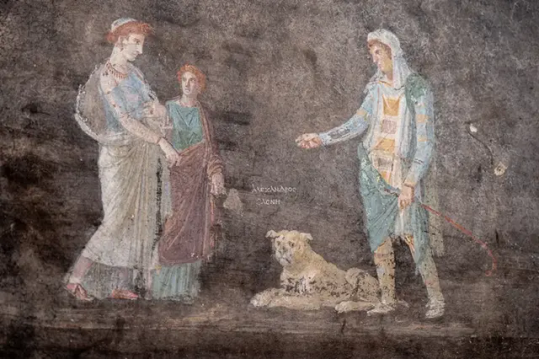
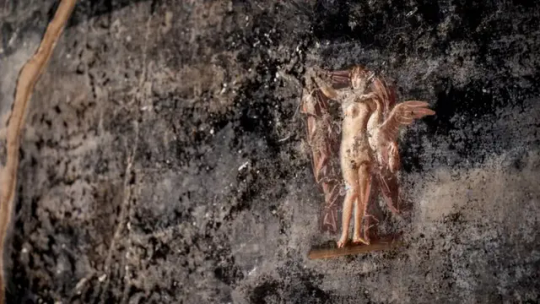
Breathtaking New Frescoes Found at Pompeii
Stunning Roman frescoes have been uncovered by archeologists in Pompeii, the ancient city destroyed by an eruption of the volcano Mount Vesuvius in the year 79 AD. Experts say the newly discovered frescoes are among the finest ever to emerge at the renowned archeological site.
The works of art line the high walls of what was once a large banquet hall. The walls themselves were painted mostly black, and the figures on the frescoes appear to emerge from the shadows. Site director Dr. Gabriel Zuchtriegel told CBS News partner network BBC News that the dark color was likely used to hide stains from the lamps that lit the hall after the sun went down.
"In the shimmering light, the paintings would have almost come to life," Zuchtriegel said.
Two pieces dominate the hall; one depicts the Greek god Apollo trying to seduce the priestess Cassandra. The second piece shows Prince Paris meeting Helen of Troy.


About a third of the "lost city" of Pompeii remains obscured by volcanic debris from the eruption almost two millennia ago. As scientists make new finds, they quickly move them to a storeroom to protect them from the elements.
The newly discovered frescoes, however, cannot be moved, so they have been protected with temporary roofing. Plaster glue is also being injected into the walls behind the artwork to stop them from falling down.
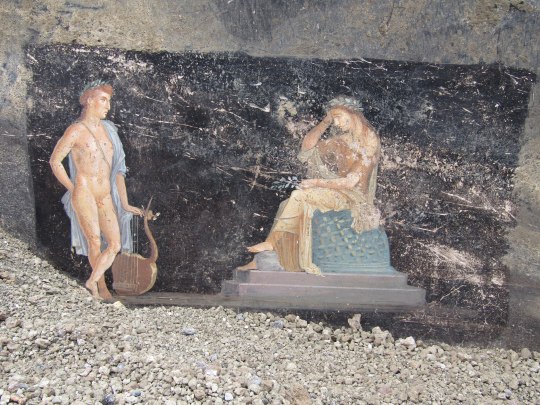
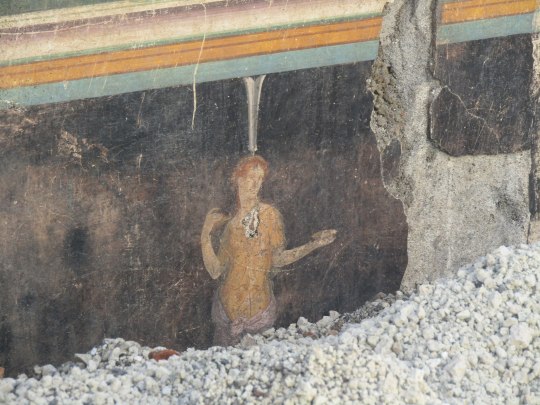

"We have a passion and a deep love for what we're doing, because what we're uncovering and protecting is for the joy also of the generations that come after us," chief restorer Dr. Roberta Prisco told the BBC, adding that the work was very stressful.
The dig site is much bigger than just the banquet hall.
Another fresco recovered from what was once one of Pompeii's grand properties had been on a ceiling, but it was smashed by the eruption that destroyed the city. Archeologists were able to lay out the pieces like a puzzle and recreate landscapes, theatrical masks, and Egyptian characters.


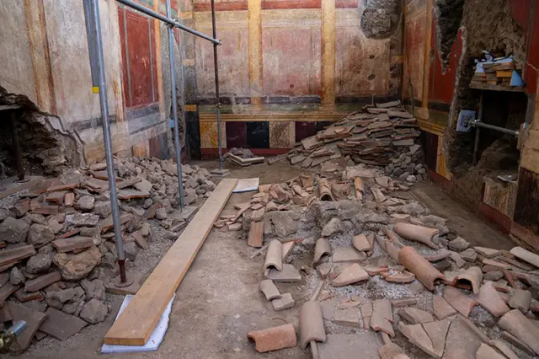
"This is my favorite discovery in this excavation because it is complex and rare," Dr. Alessandro Russo, co-lead archeologist on the dig, told the BBC. "It is high-quality, for a high-status individual."
In a bakery next to the grand property, the skeletons of two adults and a child were discovered.
Archeologists believe they may have been slaves who were trapped and couldn't flee the eruption, and were killed by falling stones.
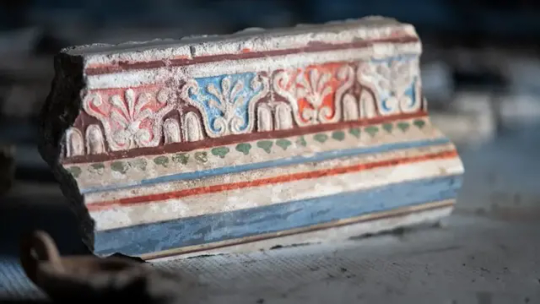
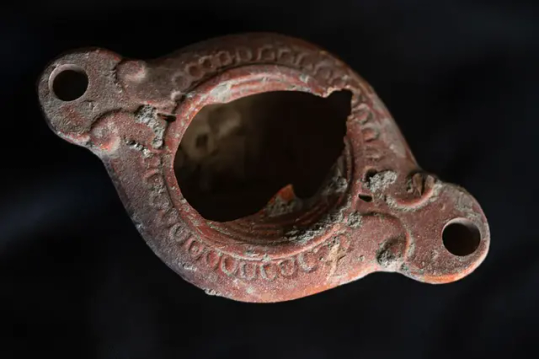
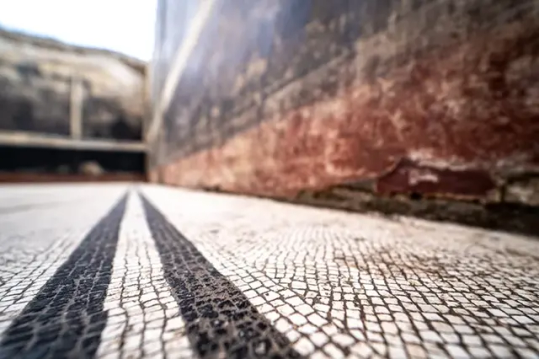
"When we excavate, we wonder what we're looking at," co-lead archeologist Dr. Gennaro Iovino told the BBC. "Much like a theater stage, you have the scenery, the backdrop, and the culprit, which is Mount Vesuvius. The archeologist has to be good at filling in the gaps — telling the story of the missing cast, the families and children, the people who are not there anymore."
The team's discovery was just one of a number of recent revelations from the site, after they found other mythological-themed frescoes in early March and then, just weeks later, a construction site that was being worked on right up until the eruption.
The archeologists said near the end of March that they'd found a home construction project that was frozen in time by the eruption, with materials such as bricks and tools still piled up in the reception area of the home.
By Haley Ott.



#Breathtaking New Frescoes Found at Pompeii#Roman frescoes#Mount Vesuvius#ancient artifacts#archeology#archeolgst#history#history news#ancient history#ancient culture#ancient civilizations#roman history#roman empire#roman art
164 notes
·
View notes
Text








2020 McLaren Senna GTR 'LM 25' by Lanzante
#McLaren Automotive#2020 McLaren Senna GTR 'LM 25' by Lanzante#automobile#car#supercar#British sports car#luxury#luxury car#luxury living#luxury lifestyle#rich#billionaire lifestyle#sexy
12 notes
·
View notes
Text







2022 Lamborghini Countach LPI 800-4
#Lamborghini#2022 Lamborghini Countach LPI 800-4#automobile#car#sports car#Italian sports car#luxury#luxury car#luxury living#luxury lifestyle#rich#billionaire lifestyle#sexy
4 notes
·
View notes
Text

Carrot Harvest Helped Metal Detectorist FindA Ancient Coins Hoard
When Alan Baxter found a medieval ring in a farmer's field he knew there could be more ancient artefacts nearby - but the stubble from the thick oat crop made it difficult for his metal detector to get anywhere near the ground. So he waited.
Four years later the farmer had planted and harvested carrots.
"It must have had a deep plough when the carrots got lifted and I could get my detector right to the soil," the 44-year-old said.
"Every 3ft I was getting a signal. I couldn't move, there was stuff everywhere.
"I didn't want to go home."
The highlight of his haul in 2022 was a hoard of farthings from the reign of 15th Century Scottish King James III.
"I got my first one and I knew it was really rare because I know my coins," he said.
"After that it was just like a tap, it just kept on going, and over the course of a few weeks I pulled 52 of them."

The 500-year-old coins, which were made of copper and were worth a quarter of a penny, were in very good condition, Mr Baxter, from Falkirk, said.
The coins are irregular shapes. They have the Saltire - the cross of St Andrew - on one side and a crown on the other.
"To hold something that's hundreds of years old for the first time is extraordinary," he said.
"You get a real buzz going up and down your body which lasts all day and all night."
An expert at the National Museum of Scotland said it was the first hoard of James III farthings to be found since 1919.
Metal detectorists need to ask for permission from landowners to search on their land and anything they find must be handed into the Treasure Trove for analysis and recording.
Under Scottish law all finds of archaeological, historical or cultural significance must be reported and can be claimed by the Crown.
Neither detectorists nor landowners have ownership rights to any archaeological finds made in Scotland.
Finds that are allocated to a museum through the Treasure Trove system are usually acknowledged by an award paid to the detectorist.
Detectorists generally split the money with the landowner.
Mr Baxter has detected at many sites, all of which he keeps a closely guarded secret. They include the 14-acre fields in Fife where he has now found more than 500 pieces ranging from the Bronze Age to the medieval period.

"I go along to farmers' doors with my portfolio of previous finds and show them what I do and ask them for permission to detect on their land," he said.
"You try to make yourself presentable, you put gel in your hair and wash your car and turn up in nice clothes.
"I hate getting permission because it's quite awkward speaking to the landowner. Farmers are busy and the last thing they want to do is speak to a wee guy asking for metal detecting permission."
The James III hoard has been put into the British numismatics journal, which charts the best finds in the country.
It also includes two Balliol coins which Mr Baxter discovered at the site in Fife. These farthings are extremely rare and are the only two to have ever been found in Scotland.
John Balliol reigned as king of Scotland from 1292 to 1296.
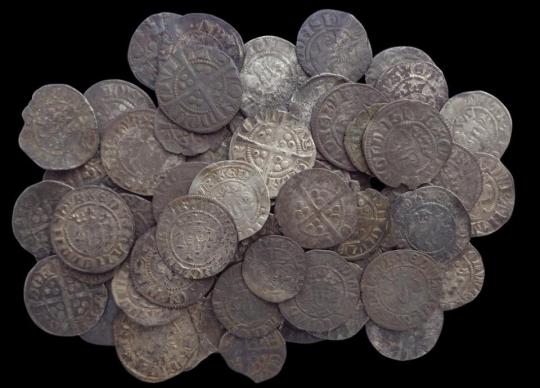

The find was allocated to the National Museums of Scotland and £5,000 was paid out.
Mr Baxter has also found 69 medieval coins from the reign of English King Edward I, whose armies invaded Scotland at the end of the 13th Century.
The medieval ring, which was his first find on the Fife site, dates between the 13th and 14th century.
"Initially I thought it was a bottle top because when it came out of the ground I could see the silver edges," Mr Baxter said.
"I saw the writing at the side and the big clasped hands at the front and I thought: 'That's a medieval ring'.
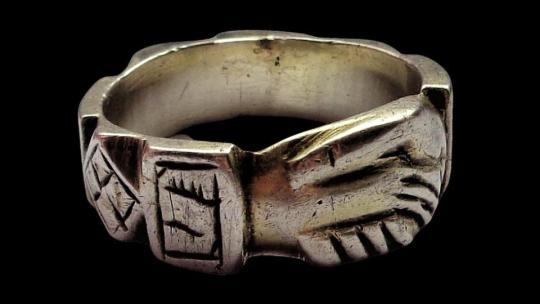
"It was just a great feeling to see it because it was a sunny day and it was twinkling away and it was in really good condition because it's been coated in gold, which has protected it from the soil."
Mr Baxter, who works as a lab technician, said he believed it was a betrothal ring.
"It would have been a higher status individual who owned it," he said.
"It weighs 9.5g, it's a heavy piece. A medieval penny would weigh about 1.2g, so that's about seven medieval pennies, so it wouldn't have been a peasant who owned that at the time."
The ring is silver but it has been coated in gold. It was eight inches down in the ground when his detector picked it up.
Mr Baxter, who has written a book entitled Making history: My Life As a Scottish Metal Detectorist, said it was hard for people to understand how difficult it was to find ancient artefacts.
He said: "In a general field 90% of the time there will be nothing in it.
"You could go in all the fields on the right and left along the M9 from Falkirk to Edinburgh and there would be nothing in them apart from modern Victorian stuff or Georgian stuff.
"It's hard to get stuff that's beyond 500 and 600 years old because the population was a lot lower."
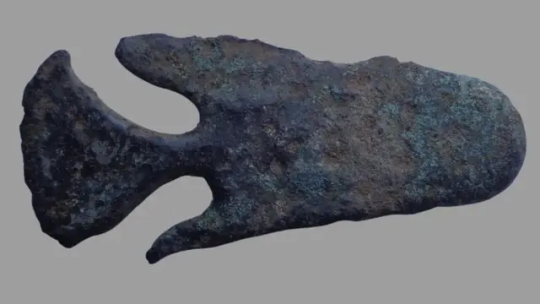
Mr Baxter said a field could be full of medieval items, but detectors were not going to find them if the crops were too high.
"Then it comes down to knowledge and the best conditions," he said.
"You need to know that the crops need to be soft cut.
"Barley and wheat is softer than oats. When oats get cut the stubble is really hard.
"And obviously the carrot harvest was the best."
By Angie Brown.

#Carrot Harvest Helped Metal Detectorist FindA Ancient Coins Hoard#Alan Baxter#Scottish King James III#coin hoard#coin collecting#hoard of farthings#metal detecting#ancient artifacts#archeology#archeolgst#history#history news#ancient history#ancient culture#ancient civilizations#medieval#middle ages#dark ages
47 notes
·
View notes
Text

Sunflower
A sunflower in the early morning sunshine in Largo, Florida.
📸 flickr
#flickr#original#original post#original photography#original photography on tumblr#tumblr#artists on tumblr#nature#nature lovers#nature photography#my photography#yellow#flower#sunflower#pretty#beauty#beautiful#blueiscoool#blueiskewl
43 notes
·
View notes
Text

A 2,000-Year-Old Gold Roman Bracelet Found in England
A 12 year old boy and his mother have discovered a Roman bracelet whilst walking their dog near the village of Pagham in West Sussex, England.
The discovery is an armilla type cuff bracelet, an armband awarded as a military decoration (donum militarium) to soldiers of ancient Rome for conspicuous gallantry.
Roman legionnaires and non-commissioned officers below the rank of centurion were eligible for an armilla, which were worn at military parades or during a Roman Triumph to publicly celebrate and sanctify the success of a military commander.
The bracelet dates from the 1st century AD and has been declared as “treasure” by a coroner’s inquest, as the object (designated SUSS-417291) is more than 300 years old and is made from gold.


According to the Portable Antiques Scheme which recorded the find, the bracelet is a folded strip of sheet gold with five raised parallel mouldings with rib and rope styles. There are visible file marks and a circular piercing made at one end from the back through to the front.
The discovery was made by Rowan Brannan from Bognor, Sussex, who reported the find to the local Finds Liaison Officer. Archaeologists examined the artefact and authenticated it as genuine piece of ancient Roman gold jewellery.
Pagham is located not far from the Romano-British city of Noviomagus Reginorum (modern-day Chichester), capital of the Civitas Reginorum.
Noviomagus Reginorum began as a winter fort for the Second Augustan Legion shortly after the Roman invasion in AD 43. The fort was garrisoned for only a few years, before being developed as a Romano-British civilian settlement in the territory of the friendly Atrebates tribe.
By: Mark Milligan.

#A 2000-Year-Old Gold Roman Bracelet Found in England#Pagham in West Sussex England#gold#gold jewelry#ancient jewelry#ancient artifacts#archeology#archeolgst#history#history news#ancient history#ancient culture#ancient civilizations#roman history#roman empire#roman legion#roman art
33 notes
·
View notes
Text

Bernard Buffet
Nature morte aux fleurs
Oil on canvas.
Executed in 1988.
#Bernard Buffet#Bernard Buffet Nature morte aux fleurs 1988#french artist#painter#painting#oil on canvas#art#artist#art work#art world#art news
20 notes
·
View notes
Text

Wu Guanzhong
Vase of Flowers
Ink and color on paper.
Signed and dated 1973.
#Wu Guanzhong#Wu Guanzhong Vase of Flowers 1973#chinese artist#painter#painting#ink and color on paper#art#artist#art work#art world#art news
10 notes
·
View notes
Text

A French Lapis Lazuli and Gilt Bronze Mantel Clock
Circa 1900
#A French Lapis Lazuli and Gilt Bronze Mantel Clock#Circa 1900#clock#antique clock#antique#blue#1900s#1900s art#1900s style#art#artist#art work#art world#art news#art deco
35 notes
·
View notes
Text
Close Call
A Ukrainian FPV suicide drone strikes a Chinese all-terrain vehicle Desertcross 1000-3 used by Russian soldiers in Ukraine.
#ukraine#russia#russian war on ukraine#drone#Ukrainian FPV suicide drone#kamikaze drones#war#world at war#weapons#battle#fighting#combat#close combat#close call
11 notes
·
View notes
Text
Avdiivka, Ukraine
This is what is left of a once beautiful city after Russian forces came calling.
#ukraine#avdiivka#russia#russian war on ukraine#russian terrorism#putin#war#world at war#weapons#battle#fighting#combat#cities in dust#sad
42 notes
·
View notes